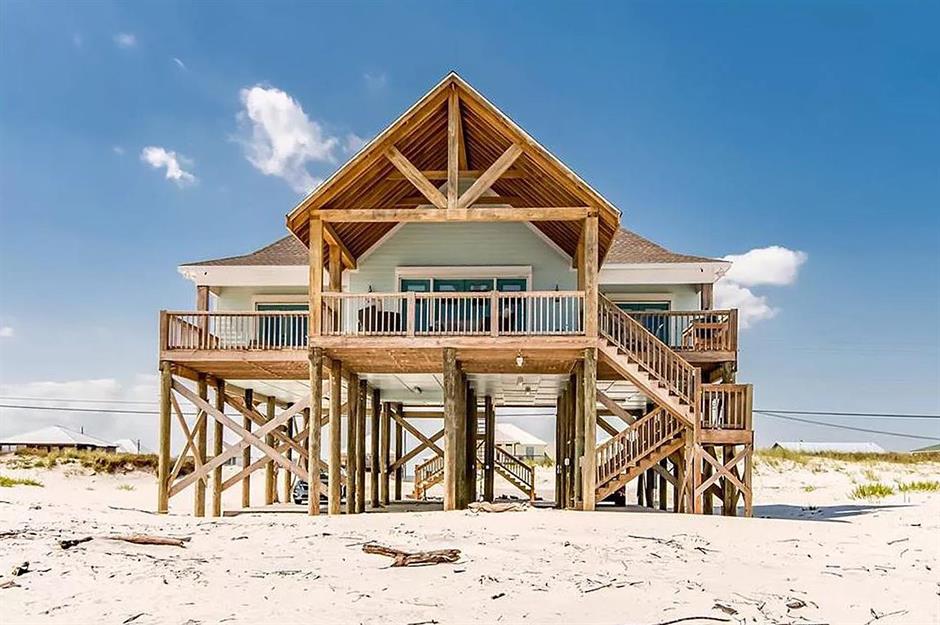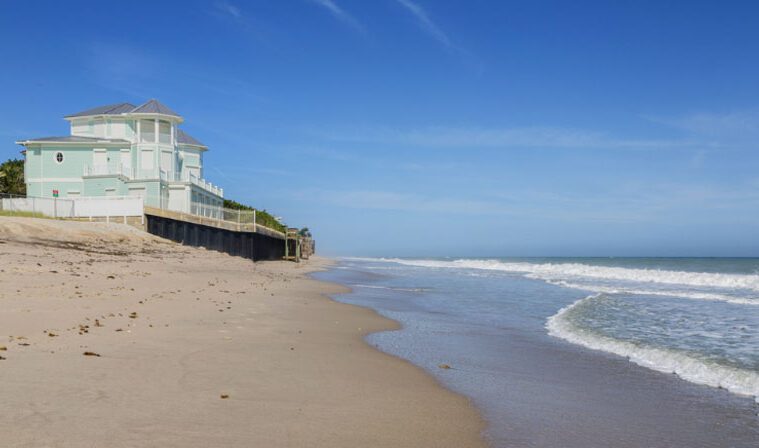Do you know why beach houses are on stilts or how they are even constructed? Read below for that information and so much more.
For many years, homes constructed on the beachside have been built on top of tall, sturdy, and durable stilts.
These homes stand right next to the water’s edge, providing a restful retreat with a relaxed atmosphere and stunning sea view.
If you have ever visited a beach or coastal area, chances are you have seen these types of houses. But do you know why they are on these long stilts or how they are even made?
Take a few minutes to dig into the fascinating history of why beach houses are built on stilts (hint: it’s not just for the view) and the exciting and detailed information on how they are constructed.


Why Are Beach Houses Built on Stilts?
The primary and most significant reason beach houses are built on stilts or pilings is to keep them safe from natural disasters and flooding. This form of home construction dates back centuries, including 5000 to 500 BC in the Alps and surrounding areas. These houses were built for elevation above wetlands, rivers, and lakes. At the time, they were called pile dwellings.
While technology in construction and architecture has changed dramatically over time, the objective remains the same: avoiding damage to homes in coastal areas.
Although brutal destruction caused by the forces of angry seas, rivers, and lakes will always remain the primary reason we build homes on stilts today, it isn’t always the only reason.
So what other benefits come from these out-of-the-ordinary houses?
- A beautiful view above the water’s edge
- Keeps home free of pests
- Provides more protection from intruders
- Provides living space in areas that would otherwise go unoccupied
- Stays sturdy even built on sand that is known for shifting and eroding
There are many benefits to beach houses being erected atop sturdy, tall stilts called pilings. So, how are they made?
How Are Beach Houses on Stilts Built?
Planning the design of a beach house on stilts, as you can imagine, is more complicated than drawing up a blueprint for your typical grounded home; it is also much more expensive. If you are planning to build a stilt house, there are a few things to think about before moving forward.
Pre-Construction Phase
Before building a stilt home on the edge of or above a body of water, you must go through a pre-construction evaluation and expenses checklist. These coastal homes are more costly to construct and require many more hoops to jump through regarding rules and regulations.
- Zoning and location
- Hurricane, tornado, and flooding risks
- Materials needed for specific areas to withstand the weather and elements
- Permits and permit fees (surveying, licensing, impact)
- New built land preparations
- Blueprints from a professional architect
These steps take considerable time and dedication to ensure you are getting the safest home while still suiting your needs.
Construction Phase
As the construction of a beach home begins, workers start with determining the grade (or level) required for that specific location and stilt house. This means deciding how high off the ground the stilts will sit. The local building departments provide this in each area based on flood maps.
Once you know how high the first floor must sit, stilts are erected by driving them into the ground, two feet deep (at low tide) or more, depending on the size of the home and the environment around you.
Once your stilt beach house plan is in place, you must prepare suitable materials for your home, including the deck, patio, etc.
Post Materials
Traditionally these posts would be bamboo or other types of wood found in the surrounding areas. Today, however, it is more common to use steel or concrete, especially when the home is built right next to water.
Posts can range from six to 25 feet in height and will anchor and support the home to land once construction is completed.
Siding Materials
Materials for coastal home siding are just as important as the ones used for the stilts. The best siding for these buildings is brick, granite, or fiber cement, the more popular option today.
These types of siding are the better choice because they are durable, strong, and can withstand the wind, salt from the water, and many other natural elements.
Roof Materials
Typically shingles are the go-to when constructing a roof on a home or building. However, these materials are no match for strong winds, harsh rains, and other rough weather. For that reason, metal roofs like galvanized and stainless steel are much better options.
Metal roofs are also much better at resisting damage caused by mildew, rot, and termites. Plus, this roof will reflect sunlight rather than absorb its heat.
Other durable options on beach home roofs are clay tile, Western red cedar, and slate.
Windows and Doors
Coastal homes must have specific doors and windows with more durable glass than typical inland houses. This has everything to do with the daily wind, waves, and natural elements these homes face.
When living on the edge of the water, your house will be more exposed to higher winds and flying or floating objects, so the glass on each entrance or opening should have the ability to withstand these issues.
When installing windows and doors into your home, you must purchase impact-resistant products, preferably with a double glaze.
Impact-resistant glass has a sound core that won’t shatter upon impact, whether due to being struck by an object or in the middle of an earthquake, tsunami, or tornado. It is also ideal for dulling outside noises and protecting your home from intruders.
Double glazing your glass will help save on utility bills by creating a secure barrier between the outdoor temperatures and elements and the conditions inside your home.
The Nuts and Bolts (and Nails)
You should consider even the most minor details when building a home on a beachfront property. These items are exposed to water, salt, and other debris 24/7, which can significantly affect them.
During construction, all nails, screws, and bolts should be galvanized, dipped, or coated with a weather-resistant material to ensure they never rust or develop algae, mold, or mildew.
Things to Consider When Building a Beach House on Stilts
Beach homes are a popular attraction for many people searching for houses near coastlines due to the spectacular views and exotic feel. However, sometimes the appeal of its beauty will win you over before you consider all the factors.
Beach Homes on Stilts Can Be Expensive
Planning and constructing a beach house can get very expensive very quickly. These houses require a lot of details, permits, and materials to ensure they are safe and livable.
To get an idea of how much the construction will cost, research every item that requires payment:
- Blueprints
- Permits
- Contractors
- Electric, plumbing, utilities
- Materials (weather- and environment-proof)
- Size of the home (the bigger it is, the more expensive it will be)
- Excavation and land clearing before building
Maintenance of Beach Homes on Stilts
Beach homes are exposed to some of the roughest and most damaging elements nature has to offer. When you own a home on stilts, you must maintain it over the years to ensure it is as safe and structurally sound as when it was first constructed.
Some of the maintenance jobs you can anticipate include:
- Roof repairs
- Siding repairs
- Power washing
- Caulking
- Window replacements
- Painting
Safety of Beach Homes on Stilts
You want to ensure you and your loved ones are safe inside and outside your home. So, whether you buy a beach house or build one yourself, you should take safety measures very seriously and ask all the right questions.
- Is the structure sound?
- Are the entrances and windows secure (especially if you have children and pets)?
- Is the location safe?
- What are the codes and regulations for the area?
Are Beach Homes on Stilts Safe?
Many people ask if beach homes on stilts are safe to live in. These houses are subject to severe weather risks and environmental conditions that cause corrosion and material breakdown.
While materials made for rough conditions will keep the buildings more secure than any other option, they can still break down over time, even galvanized steel and concrete structures.
With that said, these homes can be as safe as any other as long as they are frequently inspected and maintained. There are professional inspectors you can hire to come out and look over your property to ensure everything is on the up and up and your family is safe and secure.
Summing Things Up
Beach houses on stilts allow you to own a home as close to the water as possible. They provide families, couples, or individuals with a one-of-a-kind sea view and a chance to sleep, eat, and reside alongside the shore. This is accomplished by propping houses above sea level on sturdy, tall stilts.
While living so high off the ground might seem a little precarious at first, with the proper materials, permits, construction, and planning, your beach house on stilts can be just as safe as any other home – and come with a view that is simply unbeatable!


